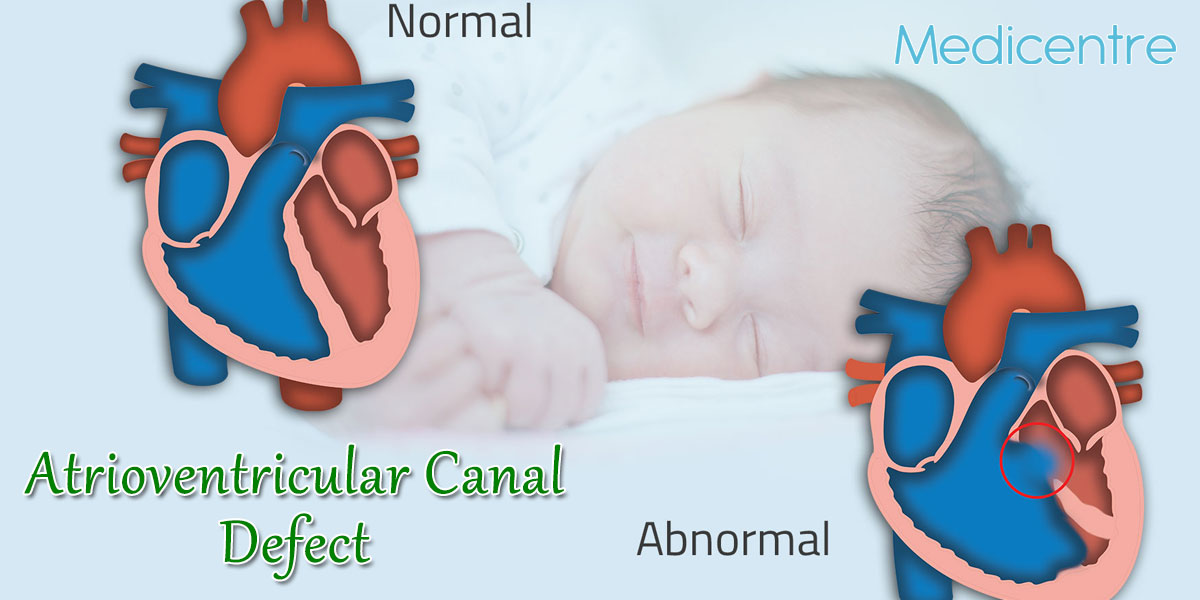Atrioventricular Canal Defect
Atrioventricular Canal Defect is the medical condition of congenital abnormalities. It is the combination of different abnormalities that occur in heart at birth time. The defect actually occurs when there is hole between chambers of heart by birth and has issues with the valves which are responsible for circulating blood across the heart. Because of Atrioventricular Canal Defect, the blood circulation in lungs increases and it also makes your heart to work harder and hence it enlarges.
In most of the cases, Atrioventricular Canal Defect is directly linked with the Down Syndrome and if it is left untreated then this may lead to heart failure and high blood pressure in lungs. Doctors usually treat Atrioventricular Canal Defect by surgical procedures during the first year of life and it aims to close the hole and rebuild valves for proper circulation.

Symptoms of Atrioventricular Canal Defect
There are two different types of Atrioventricular Canal Defect and this includes partial and complete Atrioventricular Canal Defect. In partial type only involves the two upper chambers of heart, while the complete type involves all four chambers and allows circulation across all these chambers of heart and also pumps extra blood to the lungs.
Symptoms of Complete Atrioventricular Canal Defect
- Difficulty in breathing
- Poor weight gains
- Loss of appetite
- Bluish discoloration of lips and skin
Symptoms of Partial Atrioventricular Canal Defect
- Heart failure
- Heart valve problems
- Abnormal heartbeats
- High blood pressure in lungs
Causes of Atrioventricular Canal Defect
Atrioventricular Canal Defect is commonly occurred in the fetal growth when the heart of your baby is developing during pregnancy. Some of the conditions like down syndrome increases the risk of developing Atrioventricular Canal Defect. However, in most of the cases, the actual cause of the defect is still not obvious.
What are the Risk Factors and Complications of Atrioventricular Canal Defect?
As mentioned, the exact reasons behind Atrioventricular Canal Defect is still not clear, but there are certain factors which increase the risk of developing congenital heart diseases like:
- Down syndrome which is a genetic condition results from extra 21 st chromosome
- German measles or another viral disorder during pregnancy
- Poorly controlled diabetes during pregnancy
- Alcohol abuse during pregnancy
- Taking medications during pregnancy
There are multiple complications which may arise in patients with Atrioventricular Canal Defect. Some of these complications include:
- Enlargement of heart with increased flow of blood and this forces the heart to work harder and hence it enlarges
- In some cases heart failure is also possible
- Pulmonary hypertension or high blood pressure in lungs is also possible and it is caused when increased blood is pumped in lungs by heart
- Pneumonia – Child who is left without treating Atrioventricular Canal Defect may also develop recurrent attacks of pneumonia which is the serious lung condition
Diagnosis of Atrioventricular Canal Defect
Doctors usually perform a wide variety of test during pregnancy and in these test they check the presence of Atrioventricular Canal Defect in your baby before their birth. Doctors can only detect the partial Atrioventricular Canal Defect during pregnancy and the complete Atrioventricular Canal Defect can only be noticed in the first few weeks of their life. Some of the tests include:
- Physical examination to check the heart defect
- Echocardiogram to diagnose the Atrioventricular Canal Defect which reveals the hole in wall between heart chambers and abnormal valves
- Cardiac Catheterization is also performed to diagnose Atrioventricular Canal Defect.
Treatment for Atrioventricular Canal Defect
The only treatment for Atrioventricular Canal Defect is surgery and it is performed to fix both partial and complete Atrioventricular Canal Defect. In the process, doctors close the hole in septum using 1-2 patches. These are the septum which is naturally present in heart and it becomes a part of the septum as the heart lining start growing. In the procedure, doctors also separate the larger heart valves between the lower and upper chambers into two separate valves.
In partial Atrioventricular Canal Defect, the surgical procedure also includes repairing of the mitral valve so that it can close tightly and if the repairing is not possible it will be replaced. In complete Atrioventricular Canal Defect the surgery includes separation of the single valve into two.